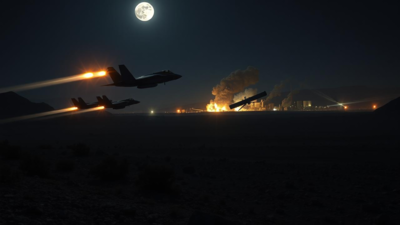Nuclear weapons, ballistic missiles: Israel’s spy files reveal why Tel Aviv had to attack Iran; ‘faced existential threat’

Israel’s foreign minister Gideon Sa’ar has sent a detailed letter to the United Nations Security Council outlining why the country launched a major military operation, named Operation Rising Lion, against Iran. In the letter, Sa’ar said the strikes were aimed at halting Iran’s nuclear and ballistic missile programs, which he described as an “existential and imminent threat” to Israel. A report by The Economist also reveals that Israel struck Iran based on intelligence that it claimed showed Iran had reached a “point of no return” in its quest for a nuclear weapon. “In the early hours of Friday, 13 June 2025, the State of Israel launched Operation Rising Lion, aimed to neutralize the existential and imminent threat from Iran’s nuclear weapon and ballistic missile programs,” Sa’ar wrote in his letter.In the letter, dated June 17, Sa’ar accused Iran of actively pursuing nuclear weapons, rapidly enriching uranium, and planning to manufacture thousands of ballistic missiles aimed at Israel. “Operation Rising Lion was launched following a critical development in Iran’s nuclear weapons program and aimed also at thwarting the imminent threat of additional Iranian missile and proxy attacks. While Iran rapidly produces highly enriched uranium, reliable intelligence confirmed in recent months that the Iranian regime had significantly accelerated its clandestine efforts to develop nuclear weapons,” the Israeli foreign minister wrote in his letter.Israel’s operation was launched on June 13, and targeted military facilities, key individuals, and infrastructure linked to Iran’s nuclear and missile programs.Sa’ar pointed out in his letter that as recently as last month, Iranian Supreme Leader Ayatollah Ali Khamenei called Israel a “cancerous tumor”. “Less than a month ago, Iran’s Supreme Leader, Ayatollah Khamenei, declared that Israel is ‘a cancerous tumor that must be eradicated and it will be’. Israel, as the Jewish homeland, cannot and will not accept the threat of extermination.”“Iran’s nuclear strategy is clear: achieve nuclear weapons which will be aimed against the State of Israel,” the letter stated. The foreign minister also cited Iran’s plans to produce 10,000 ballistic missiles in the next three years, calling it an intolerable threat. “Iran had already launched hundreds of ballistic missiles against Israel, in April 2024 and October 2024, targeting Israeli population centers and also in the last few days. Recently, Iran has accelerated its efforts in this regard and planned to produce 10,000 such missiles within the next three years.”The letter also accused Iran of supporting a wide network of armed proxies, including Hezbollah, Hamas, and the Houthis. ” Iran’s Revolutionary Guards Corps (IRGC) – which has been designated by several states as a terrorist organization – leads these efforts, inter-alia, by directly attacking Israel and by wielding Iran’s proxy network of terrorist armed groups such as Hezbollah, the Houthis, Hamas, and others. This is all part of the Iranian war plan to encircle Israel with ‘a ring of fire’, in pursuit of Israel’s annihilation, including through ground invasions into Israel’s territory,” the letter read. Sa’ar said the strikes were carried out as a last resort after diplomatic efforts failed. “Operation Rising Lion was launched as a measure of last resort. It was prompted by a critical development in lran’s covert nuclear weapons program and in response to, and in order to thwart, the threat of imminent Iranian attacks. This was the last window of opportunity to prevent Iran from acquiring nuclear weapons, and takes place after diplomacy proved ineffective. Israel is acting to defend its security and very existence.”
The Bomb files
Apart from the Iranian foreign minister’s claim of having intelligence inputs of Iran accelerating effort to develop nuclear weapon, a recent report by The Economist also pointed out that Israel carried out its strikes on Iran based on intelligence suggesting that Iran had reached a “point of no return” in its efforts to develop a nuclear weapon. According to the report, Israel also shared this intelligence with the United States and other allies.The report adds that the information presented by Israel includes a detailed description of a renewed and urgent effort by Iranian scientists to move towards “weaponisation”, the process of developing an explosive nuclear device. The dossier reportedly contains two main pieces of evidence to support this claim.Some of Israel’s intelligence assessments echo some of the details available earlier, too. They claim that a group of Iranian scientists has been engaged in both open and secret research related to nuclear weapons for several years. This activity reportedly traces back to Iran’s earlier nuclear weapons program, known as AMAD, which was shut down in 2003, likely due to concerns about a possible US attack. According to Israeli assessments, the Economist report says, the Iranian scientists continued their work under the Organisation of Defensive Innovation and Research, or SPND, using civilian research areas such as Covid-19 vaccine development and laser technology as a cover. One of the few high-ranking officials said to be aware of this ongoing work was Major-General Mohammad Bagheri, the chief of staff of Iran’s military, who oversaw both the regular armed forces and the Islamic Revolutionary Guards Corps (IRGC).However, as per the Economist report, there is also information that appears to be new in the Israeli intelligence dossiers. The documents claim that about six years ago, a group of Iranian scientists created a covert unit called the “Special Progress Group.” This group reportedly operated under the direction of Mohsen Fakhrizadeh, the former head of Iran’s AMAD nuclear weapons program. Its purpose was to lay the groundwork for a faster move toward building a nuclear weapon, in case Iran’s Supreme Leader, Ayatollah Ali Khamenei, decided to pursue that path. Fakhrizadeh was assassinated by Israel in November 2020.On June 13, at the start of the current conflict, the Israeli government made public some slides that outlined this background. However, officials also shared additional intelligence with allies, suggesting that the Special Progress Group increased its activity at the end of 2024. The assessments claim that Iran had new motivation to push ahead with nuclear weapon development at that time. It was frustrated by the limited impact of its missile attacks on Israel, its air defences had been weakened by Israeli strikes in October 2024, and its proxy forces—Hamas in Gaza and Hezbollah in Lebanon—were reportedly facing collapse.





